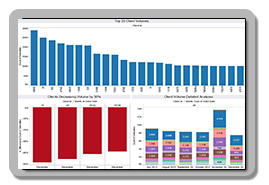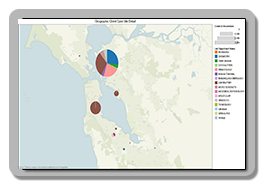2014 Strategic Planning Series:
Part 7. Drive Sales Growth & Marketing Expansion
Hospital-based outreach laboratories and larger independent laboratories are in fierce competition with each other. The larger independent laboratories offer a major competitive pricing advantage and a much larger sales force. Hospital-based laboratories often differentiate themselves by offering personalized/integrated care to a smaller market. However, both types of laboratories will benefit from having a greater understanding of their clients and deeper insight into how they can secure a larger market share for their organizations. Clients of both large and small labs will appreciate more value-add solutions that address their specific needs and problems. Having an effective client outreach program will not only improve sales, but also build a loyal client base.
Laboratories can increase their competitive advantage by adopting a healthcare-specific business intelligence (BI) solution which addresses the needs of today’s sales and marketing teams. BI solutions enable sales and marketing teams with on-demand access to client ordering volumes, revenue/profitability by client, TATs, and utilization patterns to ensure they provide the personalized attention and level of service needed to stay competitive and retain their customers in the long-term.
Challenges and Opportunities for Customer Retention
Most sales and marketing teams utilize a customer relationship management (CRM) service to manage, monitor, and streamline sales and marketing activities. Sales teams need access to test details, volumes statistics, and financial information of clients in order to fully understand their client’s specific needs. However, this information is not typically accessible within the CRM, creating a challenge for sales teams to obtain necessary information on their own. IT resources are usually required to access the data and generate the analyses, which often produces information that is outdated and un-actionable.
Analytics helps sales and marketing teams better understand their business. Providing sales teams with daily, weekly, and/or monthly client volume alerts and other custom analyses is one way to ensure sales teams are prepared to answer client questions on-the-fly and able to provide the level of personalized service required to retain customers.
 As an example of how sales teams and administrators are actively monitoring their client’s volume fluctuations, the dashboard to the left highlights the top 25 clients by total count of orderables over a specific period of time. The analysis on the bottom left indicates clients who have decreased volume during this period by 30% or more, while the analysis on the bottom right shows a specific high-risk client’s volume for a six-month period by department. This view helps sales staff become more proactive about their clients to help identify fluctuations due to holiday absences or if a customer is about to leave. Alerts provide immediate indication of where the sales team needs to take action to ensure optimal customer retention.
As an example of how sales teams and administrators are actively monitoring their client’s volume fluctuations, the dashboard to the left highlights the top 25 clients by total count of orderables over a specific period of time. The analysis on the bottom left indicates clients who have decreased volume during this period by 30% or more, while the analysis on the bottom right shows a specific high-risk client’s volume for a six-month period by department. This view helps sales staff become more proactive about their clients to help identify fluctuations due to holiday absences or if a customer is about to leave. Alerts provide immediate indication of where the sales team needs to take action to ensure optimal customer retention.
Ways to Increase Market Share
Every business needs to think about getting the most out of its marketplace. While it may be opportunistic to pick up sales wherever businesses can, this tactic is unlikely to sustain long-term progress. A more strategic approach to expanding your business is to focus on growth opportunities. Strategic vision and direction can be crafted with detailed market information to allow your business to maximize potential profits and realize new sales goals.
Business intelligence solutions provide sales and marketing teams the opportunity to track client locations and population densities. With this visibility, teams may better prioritize their activities by honing in on where opportunities may exist. Sales and marketing teams can also utilize this information to identify ordering patterns for their existing clients. Client ordering pattern maps provide the insights sales and marketing teams need to ensure each client is effectively utilizing the labs service offerings.
 As an example of how sales and marketing teams geographically prioritize their efforts, the analysis to the left shows clients within the San Francisco bay area. The size and color of the pie charts show ordering volume per department. This visualization also provides insights into clients’ ordering patterns and helps ensure the sales teams focus on clients that show potential for increased service offering utilization.
As an example of how sales and marketing teams geographically prioritize their efforts, the analysis to the left shows clients within the San Francisco bay area. The size and color of the pie charts show ordering volume per department. This visualization also provides insights into clients’ ordering patterns and helps ensure the sales teams focus on clients that show potential for increased service offering utilization.
By geographically visualizing ordering patterns, teams have an opportunity to locate clients who are only ordering specific tests or only utilizing a specific department. Certain tests may be more profitable than others, and sales and marketing teams can target tests that earn the business more money.
Value-added Service and Transparency
Laboratories can offer value beyond professional testing services. The key product of the laboratory is information. The most sophisticated laboratories recognize this significance and provide substantial value-add back to their customers through the delivery of results and other meaningful information. For example, laboratories may have Service Level Agreements (SLAs) with their customers. Customers want information on their lab testing performance and truly appreciate data transparency. However, it is difficult and pain staking for laboratories to accurately report back to customers on their performance relative to those SLAs. Business intelligence platforms enable laboratories to easily share information with their customers on order volume, test utilization, cost, TAT performance, and other key performance indicators. This transparency and differentiation deepens the partnership even further and leads to long-lasting, quality customer relationships.
Business intelligence solutions enable sales and marketing teams to better understand their clients, develop strategic plans to grow, and fortify current customer relationships through value-added information. Viewics Health Insighter (VHI) is a business platform which integrates the lab’s CRM data with clinical, financial, and operational data to provide laboratories with a better understanding of their customers, products, and sales channels. By adopting VHI, marketing and sales teams are enabled with the data they need to drive a more profitable and productive business.
For more information about the sales and marketing solutions offered from Viewics, click here and request a personalized demonstration today.
